阻塞队列BlockingQueue之ASynchronousQueue
一、SynchronousQueue简介
Java 6的并发编程包中的SynchronousQueue是一个没有数据缓冲的BlockingQueue,生产者线程对其的插入操作put必须等待消费者的移除操作take,反过来也一样。
不像ArrayBlockingQueue或LinkedListBlockingQueue,SynchronousQueue内部并没有数据缓存空间,你不能调用peek()方法来看队列中是否有数据元素,因为数据元素只有当你试着取走的时候才可能存在,不取走而只想偷窥一下是不行的,当然遍历这个队列的操作也是不允许的。队列头元素是第一个排队要插入数据的线程,而不是要交换的数据。数据是在配对的生产者和消费者线程之间直接传递的,并不会将数据缓冲数据到队列中。可以这样来理解:生产者和消费者互相等待对方,握手,然后一起离开。
特点:
1、不能在同步队列上进行 peek,因为仅在试图要取得元素时,该元素才存在;
2、除非另一个线程试图移除某个元素,否则也不能(使用任何方法)添加元素;也不能迭代队列,因为其中没有元素可用于迭代。队列的头是尝试添加到队列中的首个已排队线程元素; 如果没有已排队线程,则不添加元素并且头为 null。
3、对于其他 Collection 方法(例如 contains),SynchronousQueue 作为一个空集合。此队列不允许 null 元素。
4、它非常适合于传递性设计,在这种设计中,在一个线程中运行的对象要将某些信息、事件或任务传递给在另一个线程中运行的对象,它就必须与该对象同步。
5、对于正在等待的生产者和使用者线程而言,此类支持可选的公平排序策略。默认情况下不保证这种排序。 但是,使用公平设置为 true 所构造的队列可保证线程以 FIFO 的顺序进行访问。 公平通常会降低吞吐量,但是可以减小可变性并避免得不到服务。
6、SynchronousQueue的以下方法:
* iterator() 永远返回空,因为里面没东西。
* peek() 永远返回null。
* put() 往queue放进去一个element以后就一直wait直到有其他thread进来把这个element取走。
* offer() 往queue里放一个element后立即返回,如果碰巧这个element被另一个thread取走了,offer方法返回true,认为offer成功;否则返回false。
* offer(2000, TimeUnit.SECONDS) 往queue里放一个element但是等待指定的时间后才返回,返回的逻辑和offer()方法一样。
* take() 取出并且remove掉queue里的element(认为是在queue里的。。。),取不到东西他会一直等。
* poll() 取出并且remove掉queue里的element(认为是在queue里的。。。),只有到碰巧另外一个线程正在往queue里offer数据或者put数据的时候,该方法才会取到东西。否则立即返回null。
* poll(2000, TimeUnit.SECONDS) 等待指定的时间然后取出并且remove掉queue里的element,其实就是再等其他的thread来往里塞。
* isEmpty()永远是true。
* remainingCapacity() 永远是0。
* remove()和removeAll() 永远是false。
SynchronousQueue 内部没有容量,但是由于一个插入操作总是对应一个移除操作,反过来同样需要满足。那么一个元素就不会再SynchronousQueue 里面长时间停留,一旦有了插入线程和移除线程,元素很快就从插入线程移交给移除线程。也就是说这更像是一种信道(管道),资源从一个方向快速传递到另一方 向。显然这是一种快速传递元素的方式,也就是说在这种情况下元素总是以最快的方式从插入着(生产者)传递给移除着(消费者),这在多任务队列中是最快处理任务的方式。在线程池里的一个典型应用是Executors.newCachedThreadPool()就使用了SynchronousQueue,这个线程池根据需要(新任务到来时)创建新的线程,如果有空闲线程则会重复使用,线程空闲了60秒后会被回收。
二、 使用示例
package com.dxz.queue.block;
import java.util.concurrent.SynchronousQueue;
public class SynchronousQueueDemo {
public static void main(String[] args) throws InterruptedException {
final SynchronousQueue<Integer> queue = new SynchronousQueue<Integer>();
Thread putThread = new Thread(new Runnable() {
@Override
public void run() {
System.out.println("put thread start");
try {
queue.put(1);
} catch (InterruptedException e) {
}
System.out.println("put thread end");
}
});
Thread takeThread = new Thread(new Runnable() {
@Override
public void run() {
System.out.println("take thread start");
try {
System.out.println("take from putThread: " + queue.take());
} catch (InterruptedException e) {
}
System.out.println("take thread end");
}
});
putThread.start();
Thread.sleep(1000);
takeThread.start();
}
}
三、实现原理
3.1、阻塞算法实现
3.1.1、使用wait和notify实现
阻塞算法实现通常在内部采用一个锁来保证多个线程中的put()和take()方法是串行执行的。采用锁的开销是比较大的,还会存在一种情况是线程A持有线程B需要的锁,B必须一直等待A释放锁,即使A可能一段时间内因为B的优先级比较高而得不到时间片运行。所以在高性能的应用中我们常常希望规避锁的使用。
package com.dxz.queue.block;
public class NativeSynchronousQueue<E> {
boolean putting = false;
E item = null;
public synchronized E take() throws InterruptedException {
while (item == null)
wait();
E e = item;
item = null;
notifyAll();
return e;
}
public synchronized void put(E e) throws InterruptedException {
if (e == null)
return;
while (putting)
wait();
putting = true;
item = e;
notifyAll();
while (item != null)
wait();
putting = false;
notifyAll();
}
}
package com.dxz.queue.block;
public class NativeSynchronousQueueTest {
public static void main(String[] args) throws InterruptedException {
final NativeSynchronousQueue<String> queue = new NativeSynchronousQueue<String>();
Thread putThread = new Thread(new Runnable() {
@Override
public void run() {
System.out.println("put thread start");
try {
queue.put("1");
} catch (InterruptedException e) {
}
System.out.println("put thread end");
}
});
Thread takeThread = new Thread(new Runnable() {
@Override
public void run() {
System.out.println("take thread start");
try {
System.out.println("take from putThread: " + queue.take());
} catch (InterruptedException e) {
}
System.out.println("take thread end");
}
});
putThread.start();
Thread.sleep(1000);
takeThread.start();
}
}
结果:
put thread start
take thread start
put thread end
take from putThread: 1
take thread end
3.1.2、信号量实现
经典同步队列实现采用了三个信号量,代码很简单,比较容易理解:
package com.dxz.queue.block;
import java.util.concurrent.Semaphore;
public class SemaphoreSynchronousQueue<E> {
E item = null;
Semaphore sync = new Semaphore(0);
Semaphore send = new Semaphore(1);
Semaphore recv = new Semaphore(0);
public E take() throws InterruptedException {
recv.acquire();
E x = item;
sync.release();
send.release();
return x;
}
public void put (E x) throws InterruptedException{
send.acquire();
item = x;
recv.release();
sync.acquire();
}
}
package com.dxz.queue.block;
public class SemaphoreSynchronousQueueTest {
public static void main(String[] args) throws InterruptedException {
final SemaphoreSynchronousQueue<String> queue = new SemaphoreSynchronousQueue<String>();
Thread putThread = new Thread(new Runnable() {
@Override
public void run() {
System.out.println("put thread start");
try {
queue.put("1");
} catch (InterruptedException e) {
}
System.out.println("put thread end");
}
});
Thread takeThread = new Thread(new Runnable() {
@Override
public void run() {
System.out.println("take thread start");
try {
System.out.println("take from putThread: " + queue.take());
} catch (InterruptedException e) {
}
System.out.println("take thread end");
}
});
putThread.start();
Thread.sleep(1000);
takeThread.start();
}
}
结果:
put thread start
take thread start
take from putThread: 1
take thread end
put thread end
在多核机器上,上面方法的同步代价仍然较高,操作系统调度器需要上千个时间片来阻塞或唤醒线程,而上面的实现即使在生产者put()时已经有一个消费者在等待的情况下,阻塞和唤醒的调用仍然需要。
3.1.3、Java 5实现
package com.dxz.queue.block; import java.util.Queue;
import java.util.concurrent.locks.AbstractQueuedSynchronizer;
import java.util.concurrent.locks.ReentrantLock; public class Java5SynchronousQueue<E> {
ReentrantLock qlock = new ReentrantLock();
Queue waitingProducers = new Queue();
Queue waitingConsumers = new Queue(); static class Node extends AbstractQueuedSynchronizer {
E item;
Node next; Node(Object x) { item = x; }
void waitForTake() { /* (uses AQS) */ }
E waitForPut() { /* (uses AQS) */ }
} public E take() {
Node node;
boolean mustWait;
qlock.lock();
node = waitingProducers.pop();
if(mustWait = (node == null))
node = waitingConsumers.push(null);
qlock.unlock(); if (mustWait)
return node.waitForPut();
else
return node.item;
} public void put(E e) {
Node node;
boolean mustWait;
qlock.lock();
node = waitingConsumers.pop();
if (mustWait = (node == null))
node = waitingProducers.push(e);
qlock.unlock(); if (mustWait)
node.waitForTake();
else
node.item = e;
}
}
Java 5的实现相对来说做了一些优化,只使用了一个锁,使用队列代替信号量也可以允许发布者直接发布数据,而不是要首先从阻塞在信号量处被唤醒。
3.1.4、Java6实现
Java 6的SynchronousQueue的实现采用了一种性能更好的无锁算法 — 扩展的“Dual stack and Dual queue”算法。性能比Java5的实现有较大提升。竞争机制支持公平和非公平两种:非公平竞争模式使用的数据结构是后进先出栈(Lifo Stack);公平竞争模式则使用先进先出队列(Fifo Queue),性能上两者是相当的,一般情况下,Fifo通常可以支持更大的吞吐量,但Lifo可以更大程度的保持线程的本地化。
代码实现里的Dual Queue或Stack内部是用链表(LinkedList)来实现的,其节点状态为以下三种情况:
- 持有数据 – put()方法的元素
- 持有请求 – take()方法
- 空
这个算法的特点就是任何操作都可以根据节点的状态判断执行,而不需要用到锁。
其核心接口是Transfer,生产者的put或消费者的take都使用这个接口,根据第一个参数来区别是入列(栈)还是出列(栈)。
/**
* Shared internal API for dual stacks and queues.
*/
static abstract class Transferer {
/**
* Performs a put or take.
*
* @param e if non-null, the item to be handed to a consumer;
* if null, requests that transfer return an item
* offered by producer.
* @param timed if this operation should timeout
* @param nanos the timeout, in nanoseconds
* @return if non-null, the item provided or received; if null,
* the operation failed due to timeout or interrupt --
* the caller can distinguish which of these occurred
* by checking Thread.interrupted.
*/
abstract Object transfer(Object e, boolean timed, long nanos);
}
TransferQueue实现如下(摘自Java 6源代码),入列和出列都基于Spin和CAS方法:
/*
* Puts or takes an item.
*/
Object transfer(Object e, boolean timed, long nanos) {
/* Basic algorithm is to loop trying to take either of
* two actions:
*
* 1. If queue apparently empty or holding same-mode nodes,
* try to add node to queue of waiters, wait to be
* fulfilled (or cancelled) and return matching item.
*
* 2. If queue apparently contains waiting items, and this
* call is of complementary mode, try to fulfill by CAS'ing
* item field of waiting node and dequeuing it, and then
* returning matching item.
*
* In each case, along the way, check for and try to help
* advance head and tail on behalf of other stalled/slow
* threads.
*
* The loop starts off with a null check guarding against
* seeing uninitialized head or tail values. This never
* happens in current SynchronousQueue, but could if
* callers held non-volatile/final ref to the
* transferer. The check is here anyway because it places
* null checks at top of loop, which is usually faster
* than having them implicitly interspersed.
*/ QNode s = null; // constructed/reused as needed
boolean isData = (e != null); for (;;) {
QNode t = tail;
QNode h = head;
if (t == null || h == null) // saw uninitialized value
continue; // spin if (h == t || t.isData == isData) { // empty or same-mode
QNode tn = t.next;
if (t != tail) // inconsistent read
continue;
if (tn != null) { // lagging tail
advanceTail(t, tn);
continue;
}
if (timed && nanos <= 0) // can't wait
return null;
if (s == null)
s = new QNode(e, isData);
if (!t.casNext(null, s)) // failed to link in
continue; advanceTail(t, s); // swing tail and wait
Object x = awaitFulfill(s, e, timed, nanos);
if (x == s) { // wait was cancelled
clean(t, s);
return null;
} if (!s.isOffList()) { // not already unlinked
advanceHead(t, s); // unlink if head
if (x != null) // and forget fields
s.item = s;
s.waiter = null;
}
return (x != null)? x : e; } else { // complementary-mode
QNode m = h.next; // node to fulfill
if (t != tail || m == null || h != head)
continue; // inconsistent read Object x = m.item;
if (isData == (x != null) || // m already fulfilled
x == m || // m cancelled
!m.casItem(x, e)) { // lost CAS
advanceHead(h, m); // dequeue and retry
continue;
} advanceHead(h, m); // successfully fulfilled
LockSupport.unpark(m.waiter);
return (x != null)? x : e;
}
}
}
3.2、SynchronousQueue实现原理
不像ArrayBlockingQueue、LinkedBlockingDeque之类的阻塞队列依赖AQS实现并发操作,SynchronousQueue直接使用CAS实现线程的安全访问。由于源码中充斥着大量的CAS代码,不易于理解,所以按照笔者的风格,接下来会使用简单的示例来描述背后的实现模型。
队列的实现策略通常分为公平模式和非公平模式,接下来将分别进行说明。
3.2.1、公平模式下的模型:
公平模式下,底层实现使用的是TransferQueue这个内部队列,它有一个head和tail指针,用于指向当前正在等待匹配的线程节点。
初始化时,TransferQueue的状态如下:
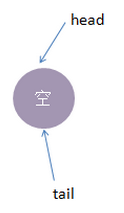
接着我们进行一些操作:
1、线程put1执行 put(1)操作,由于当前没有配对的消费线程,所以put1线程入队列,自旋一小会后睡眠等待,这时队列状态如下:

2、接着,线程put2执行了put(2)操作,跟前面一样,put2线程入队列,自旋一小会后睡眠等待,这时队列状态如下:
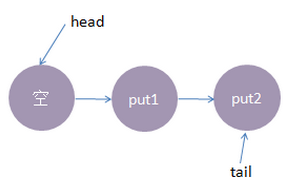
3、这时候,来了一个线程take1,执行了 take操作,由于tail指向put2线程,put2线程跟take1线程配对了(一put一take),这时take1线程不需要入队,但是请注意了,这时候,要唤醒的线程并不是put2,而是put1。为何? 大家应该知道我们现在讲的是公平策略,所谓公平就是谁先入队了,谁就优先被唤醒,我们的例子明显是put1应该优先被唤醒。至于读者可能会有一个疑问,明明是take1线程跟put2线程匹配上了,结果是put1线程被唤醒消费,怎么确保take1线程一定可以和次首节点(head.next)也是匹配的呢?其实大家可以拿个纸画一画,就会发现真的就是这样的。
公平策略总结下来就是:队尾匹配队头出队。
执行后put1线程被唤醒,take1线程的 take()方法返回了1(put1线程的数据),这样就实现了线程间的一对一通信,这时候内部状态如下:
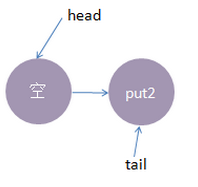
4、最后,再来一个线程take2,执行take操作,这时候只有put2线程在等候,而且两个线程匹配上了,线程put2被唤醒,take2线程take操作返回了2(线程put2的数据),这时候队列又回到了起点,如下所示:
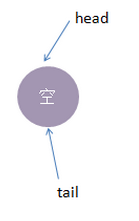
以上便是公平模式下,SynchronousQueue的实现模型。总结下来就是:队尾匹配队头出队,先进先出,体现公平原则。
非公平模式下的模型:
我们还是使用跟公平模式下一样的操作流程,对比两种策略下有何不同。非公平模式底层的实现使用的是TransferStack,一个栈,实现中用head指针指向栈顶,接着我们看看它的实现模型:
1、线程put1执行 put(1)操作,由于当前没有配对的消费线程,所以put1线程入栈,自旋一小会后睡眠等待,这时栈状态如下:
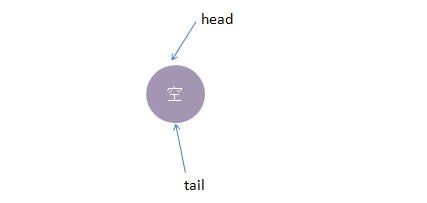
2、接着,线程put2再次执行了put(2)操作,跟前面一样,put2线程入栈,自旋一小会后睡眠等待,这时栈状态如下:
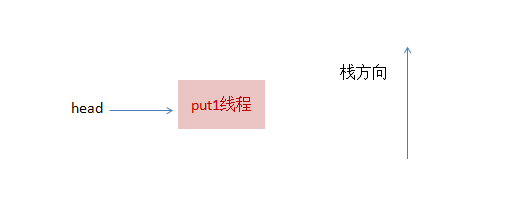
3、这时候,来了一个线程take1,执行了take操作,这时候发现栈顶为put2线程,匹配成功,但是实现会先把take1线程入栈,然后take1线程循环执行匹配put2线程逻辑,一旦发现没有并发冲突,就会把栈顶指针直接指向 put1线程

4、最后,再来一个线程take2,执行take操作,这跟步骤3的逻辑基本是一致的,take2线程入栈,然后在循环中匹配put1线程,最终全部匹配完毕,栈变为空,恢复初始状态,如下图所示:
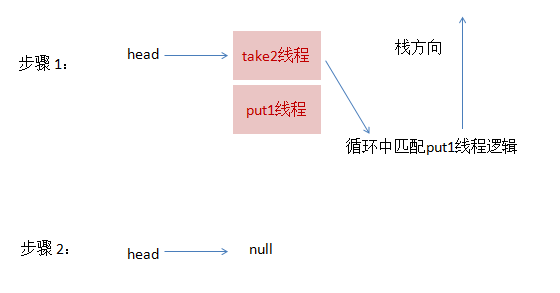
可以从上面流程看出,虽然put1线程先入栈了,但是却是后匹配,这就是非公平的由来。
总结
SynchronousQueue由于其独有的线程一一配对通信机制,在大部分平常开发中,可能都不太会用到,但线程池技术中会有所使用,由于内部没有使用AQS,而是直接使用CAS,所以代码理解起来会比较困难,但这并不妨碍我们理解底层的实现模型,在理解了模型的基础上,有兴趣的话再查阅源码,就会有方向感,看起来也会比较容易,希望本文有所借鉴意义。
原文链接:https://www.cnblogs.com/duanxz/p/3252267.html
阻塞队列BlockingQueue之ASynchronousQueue的更多相关文章
- Java并发编程-阻塞队列(BlockingQueue)的实现原理
背景:总结JUC下面的阻塞队列的实现,很方便写生产者消费者模式. 常用操作方法 常用的实现类 ArrayBlockingQueue DelayQueue LinkedBlockingQueue Pri ...
- Java并发(十八):阻塞队列BlockingQueue
阻塞队列(BlockingQueue)是一个支持两个附加操作的队列. 这两个附加的操作是:在队列为空时,获取元素的线程会等待队列变为非空.当队列满时,存储元素的线程会等待队列可用. 阻塞队列常用于生产 ...
- spring线程池ThreadPoolTaskExecutor与阻塞队列BlockingQueue
一: ThreadPoolTaskExecutor是一个spring的线程池技术,查看代码可以看到这样一个字段: private ThreadPoolExecutor threadPoolExecut ...
- Java阻塞队列(BlockingQueue)实现 生产者/消费者 示例
Java阻塞队列(BlockingQueue)实现 生产者/消费者 示例 本文由 TonySpark 翻译自 Javarevisited.转载请参见文章末尾的要求. Java.util.concurr ...
- 并发编程-concurrent指南-阻塞队列BlockingQueue
阻塞队列BlockingQueue,java.util.concurrent下的BlockingQueue接口表示一个线程放入和提取实例的队列. 适用场景: BlockingQueue通常用于一个线程 ...
- Java并发指南11:解读 Java 阻塞队列 BlockingQueue
解读 Java 并发队列 BlockingQueue 转自:https://javadoop.com/post/java-concurrent-queue 最近得空,想写篇文章好好说说 java 线程 ...
- 阻塞队列BlockingQueue用法
多线程环境中,通过队列可以很容易实现数据共享,比如经典的“生产者”和“消费者”模型中,通过队列可以很便利地实现两者之间的数据共享. 假设我们有若干生产者线程,另外又有若干个消费者线程.如果生产者线程需 ...
- 阻塞队列BlockingQueue用法(转)
多线程环境中,通过队列可以很容易实现数据共享,比如经典的“生产者”和“消费者”模型中,通过队列可以很便利地实现两者之间的数据共享. 假设我们有若干生产者线程,另外又有若干个消费者线程.如果生产者线程需 ...
- 阻塞队列BlockingQueue
BlockingQueue最终会有四种状况,抛出异常.返回特殊值.阻塞.超时,下表总结了这些方法: 抛出异常 特殊值 阻塞 超时 插入 add(e) offer(e) put(e) offer(e, ...
随机推荐
- Codeforces Round #620 (Div. 2) D
构造一个排列,要求相邻之间的数满足给定的大小关系,然后构造出两个序列,一个序列是所有可能的序列中LIS最长的,一个所有可能的序列中LIS最短的 最短的构造方法:我们考虑所有单调递增的部分,可以发现要让 ...
- PAT (Basic Level) Practice (中文)1043 输出PATest (20 分)
给定一个长度不超过 1 的.仅由英文字母构成的字符串.请将字符重新调整顺序,按 PATestPATest.... 这样的顺序输出,并忽略其它字符.当然,六种字符的个数不一定是一样多的,若某种字符已经输 ...
- Sentence by defender
也许,人在旅途,不是你看清了多少事,而是你看轻了多少事.
- 2级搭建类202-Oracle 18c SI ASM 静默搭建(OEL7.7)公开
Oracle 18c 单实例 ASM UDEV 方式在 OEL 7.7 上的安装
- 135.在django中操作cookie
操作cookie 设置cookie 设置cookie是设置值给浏览器的,因此我们可以通过response的对象来设置,可以通过HttpResponse的对象或者是HttpResponseBase的子类 ...
- 解决苹果手机app store下载软件超过200M后必须使用wifi的终极方法(亲测有效)
前言 最近使用苹果手机下载一款大小为300M左右的软件时弹出如下提示 因为平时主要使用wifi下载,偶尔用自己的流量也没有超过200M,所以用了这么久才发现苹果手机有这样一个限制. 这让我有些郁闷 ...
- laravel框架用使用session 和cookie
1.介绍 cookie 位于用户的计算机上,用来维护用户计算机中的信息,直到用户删除.比如我们在网页上登录某个软件时输入用户名及密码时如果保存为cookie,则每次我们访问的时候就不需要登录网站了.我 ...
- javascript初学笔记
基本语句 赋值条件循环语句 javascript异常处理语句 trycatchfinally语句 Error对象 throw语句 函数 定义 调用 嵌套函数 函数的嵌套定义 内置函数 匿名函数和Fun ...
- 目标检测,主要问题发展,非极大值抑制中阈值也作为参数去学习更满足end2end,最近发展趋势和主要研究思路方向
目标检测,主要问题发展,非极大值抑制中阈值也作为参数去学习更满足end2end,最近发展趋势和主要研究思路方向 待办 目标检测问题时间线 特征金字塔加滑窗 对象框推荐 回归算法回归对象框 多尺度检测 ...
- 微信小程序之数组操作:push与concat的区别
微信小程序中需要用到数组的操作,push和concat二者功能很相像,但有两点区别. 先看如下例子: var arr = []; arr.push(); arr.push(); arr.push([, ...
